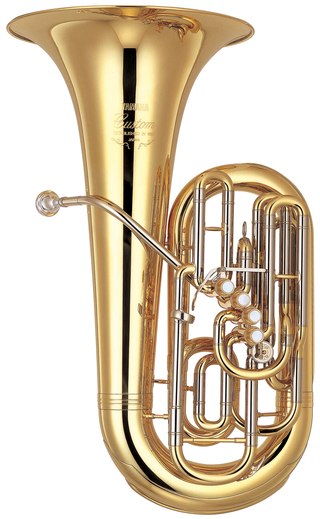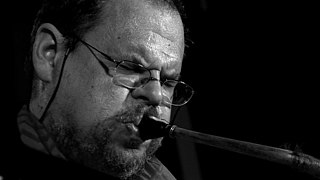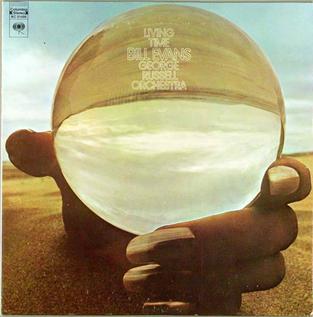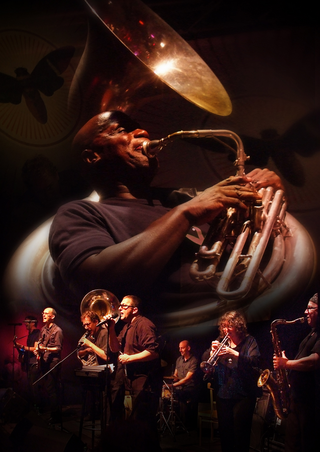
The tuba is the largest and lowest-pitched musical instrument in the brass family. As with all brass instruments, the sound is produced by lip vibration – a buzz – into a mouthpiece. It first appeared in the mid-19th century, making it one of the newer instruments in the modern orchestra and concert band, and largely replaced the ophicleide. Tuba is Latin for "trumpet".

The sousaphone is a brass instrument in the tuba family. Created around 1893 by J. W. Pepper at the direction of American bandleader John Philip Sousa, it was designed to be easier to play than the concert tuba while standing or marching, as well as to carry the sound of the instrument above the heads of the band. Like the tuba, sound is produced by moving air past the lips, causing them to vibrate or "buzz" into a large cupped mouthpiece. Unlike the tuba, the instrument is bent in a circle to fit around the body of the musician; it ends in a large, flaring bell that is pointed forward, projecting the sound ahead of the player. Because of the ease of carrying and the direction of sound, it is widely employed in marching bands, as well as various other musical genres. Sousaphones were originally made of brass. Beginning in the mid-20th century, some sousaphones have also been made of lighter materials such as fiberglass & plastic.

Howard Lewis Johnson was an American jazz musician, known mainly for his work on tuba and baritone saxophone, although he also played the bass clarinet, trumpet, and other reed instruments. He is known to have expanded the tuba’s known capacities in jazz.

The cimbasso is a low brass instrument that covers the same range as a tuba or contrabass trombone. First appearing in Italy in the early 19th century as an upright serpent, the term cimbasso came to denote several instruments that could play the lowest brass part in 19th century Italian opera orchestras. The modern cimbasso design, first appearing as the trombone basso Verdi in the 1880s, has four to six rotary valves, a forward-facing bell, and a predominantly cylindrical bore. These features lend its sound to the bass of the trombone family rather than the tuba, and its valves allow for more agility than a contrabass trombone. Like the modern contrabass trombone, it is most often pitched in F, although models are occasionally made in E♭ and low C or B♭.

Bob Stewart is an American jazz tuba player and music teacher.

The Preservation Hall Jazz Band is a New Orleans jazz band founded in New Orleans by tuba player Allan Jaffe in the early 1960s. The band derives its name from Preservation Hall in the French Quarter. In 2005, the Hall's doors were closed for a period of time due to Hurricane Katrina, but the band continued to tour.
David W. Bargeron is an American trombonist and tuba player who was a member of the jazz-rock group Blood, Sweat & Tears.

Michel Godard is a French avant-garde jazz and classical musician. He plays tuba and the predecessor of the tuba, a brass instrument known as the serpent.
Velvet Brown is an American tubist and euphonium player. She is currently a Distinguished Professor of Music at Pennsylvania State University, prior to which she taught at Bowling Green State University and Ball State University.

The Real Thing is a double live album by Taj Mahal, released in 1971. It was recorded on February 13, 1971, at the Fillmore East in New York City and features Taj Mahal backed by a band that includes four tuba players.

Living Time is an album by the Bill Evans George Russell Orchestra recorded in 1972 and released on the Columbia label, featuring performances by Evans with an orchestra conducted by Russell.

Theatre is an album by George Gruntz's Concert Jazz Band '83 recorded in July 1983 and released on ECM the following year.
Nedra Johnson is an American rhythm and blues and jazz singer/songwriter and multi-instrumentalist. She has performed internationally at jazz, blues, pride and women's music festivals as a solo artist, a tuba player, and vocalist.
Kenwood Marshall Dennard is an American jazz drummer and retired professor from Berklee College of Music in Boston, MA.

Big Band Record is an album by trombonist Ray Anderson and the George Gruntz Concert Jazz Band which was released on the Gramavision label in 1994.

First Prize is an album by pianist and composer George Gruntz's Concert Jazz Band, which was recorded in Switzerland in 1989 and released on Enja Records.

Joseph Peter Daley is an American educator, jazz musician, composer and arranger known for his work with the tuba, trombone and euphonium.

The soprano trombone is the soprano instrument in the trombone family of brass instruments, pitched in B♭ an octave above the tenor trombone. As the bore, bell and mouthpiece are similar to the B♭ trumpet, it tends to be played by trumpet players rather than trombonists. Compared to tenor, bass, or even uncommon alto, the soprano is a rare trombone. Seldom used in classical music since its first known appearance in 1677, it survived principally in the trombone ensembles of Moravian Church music. During the 20th century some soprano trombones—dubbed slide cornets—were made as novelties or for use by jazz trumpet players including Louis Armstrong and Dizzy Gillespie. A small number of contemporary proponents of the instrument include jazz artists Wycliffe Gordon and Christian Scott, and classical trumpeter Torbjörn Hultmark, who advocates for its use as an instrument for young children to learn the trombone.

Right Now! is an album by multi-instrumentalist Howard Johnson and his band Gravity, with guest vocalist Taj Mahal appearing on three tracks. Johnson's third release as a leader, it was recorded during December 1996 at Manhattan Center Studios in New York City, and was issued in 1997 by Verve Records. On the album, Johnson is joined by tubists Dave Bargeron, Joseph Daley, Nedra Johnson, Carl Kleinsteuber, Earl McIntyre, and Bob Stewart, pianist Ray Chew, double bassist James Cammack, and drummer Kenwood Dennard.















